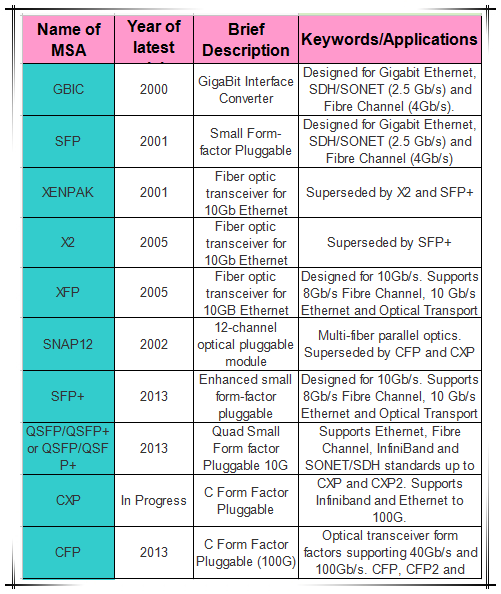When talking about fiber optic transceivers, we may encounter a term — MSA (Multi-Source Agreement). But what is MSA? It seems likes an universal organization that defines all the fiber optic transceivers and many other telecom products. However, this understanding of MSA only stays at the surface. In this passage, a clearer introduction to MSAs and why they are so important to fiber optic transceiver vendors will be presented. Just read the following text and you will gain somethings from it.
What Does MSA Mean?
MSA is short for Multi-Source Agreement. MSAs are not official standards organizations. Rather, they are agreements between multiple manufacturers in order to make products which are compatible across vendors, acting as de facto standards, establishing a competitive market for interoperable products.
MSA is short for Multi-Source Agreement. MSAs are not official standards organizations. Rather, they are agreements between multiple manufacturers in order to make products which are compatible across vendors, acting as de facto standards, establishing a competitive market for interoperable products.
MSAs strictly define the operating characteristics of these optical transceivers so that system vendors may implement ports in their devices that allow MSA compliant transceivers produced by name brand, as well as third party vendors, to function properly. That is, transceivers may be purchased from any of the multiple sources in the open market, like Fiberstore. This gives end users more choice when selecting module vendors, which serve to drive down cost through economies of scale.
Approved Fiber Optica Transceiver Multi-source Agreements
MSA is a popular industry format jointly developed and supported by many network component vendors, most common optical transceivers are specified by it at present. Currently, the approved MSAs cover the transceivers are listed in the following figure.
MSA is a popular industry format jointly developed and supported by many network component vendors, most common optical transceivers are specified by it at present. Currently, the approved MSAs cover the transceivers are listed in the following figure.

Importance of MSA
MSAs, as we have talked above, defined the characteristics of any type of fiber optic transceiver system. To customers, MSAs are primarily important because they can give them piece of mind that transceiver devices will have a basic level of operability. With MSAs, consumers have more freedom in the choices for suppliers from which they purchase products, because the basic functionality and operability of all transceiver devices will be the same within these devices. Of course, some products may be superior than other. This will allow people to compete and gain a share of the market without creating a design that’s completely different from all other devices. To the industry, before MSAs launched, a couple of companies get together, work behind closed doors, and now these standards force suppliers to be efficient and creative to find ways to drive costs down and offer customers more for their money. However, some system vendors have attempted to subvert the standardizing value of the MSAs and tried to find loopholes around the value around the MSAs.
MSAs, as we have talked above, defined the characteristics of any type of fiber optic transceiver system. To customers, MSAs are primarily important because they can give them piece of mind that transceiver devices will have a basic level of operability. With MSAs, consumers have more freedom in the choices for suppliers from which they purchase products, because the basic functionality and operability of all transceiver devices will be the same within these devices. Of course, some products may be superior than other. This will allow people to compete and gain a share of the market without creating a design that’s completely different from all other devices. To the industry, before MSAs launched, a couple of companies get together, work behind closed doors, and now these standards force suppliers to be efficient and creative to find ways to drive costs down and offer customers more for their money. However, some system vendors have attempted to subvert the standardizing value of the MSAs and tried to find loopholes around the value around the MSAs.
The most common scheme is to write a unique code into some of the undefined memory in the EEPROM of each fiber optic transceivers. When the transceiver is inserted into the host switch, its EEPROM is read, and, if the code is “incorrect” the module is rejected as “incompatible”. Though the unique code seems like a barrier for the 3rd party transceiver suppliers, many module vendors have determined how to generate and program certain parts with proper codes. Because of this, they are not distinguishable from the brand name parts of the host systems. System vendors will use the tactics to protect consumers from grossly inflated prices. They also introduce standards to support and encourage creation and standards.
Summary
MSAs have built a new way of innovation instead of market monopoly for the optical industry, and bring both opportunity and challenge to users and this industry. Fiberstore provides a full range of fiber optic transceivers including SFP, SFP+, X2, XENPAK, XFP, GBIC, QSFP/QSFP+, CFP. Most of the basic transceivers are with ready stock. Currently, J8177B (compatible HP 1000BASE-T SFP) and JD099B (compatible HP 1000BASE 1490nmTX/1310nmRX BIDI SFP) are available and have more discount.
MSAs have built a new way of innovation instead of market monopoly for the optical industry, and bring both opportunity and challenge to users and this industry. Fiberstore provides a full range of fiber optic transceivers including SFP, SFP+, X2, XENPAK, XFP, GBIC, QSFP/QSFP+, CFP. Most of the basic transceivers are with ready stock. Currently, J8177B (compatible HP 1000BASE-T SFP) and JD099B (compatible HP 1000BASE 1490nmTX/1310nmRX BIDI SFP) are available and have more discount.

Thank you for the information structured cabling service
ReplyDelete